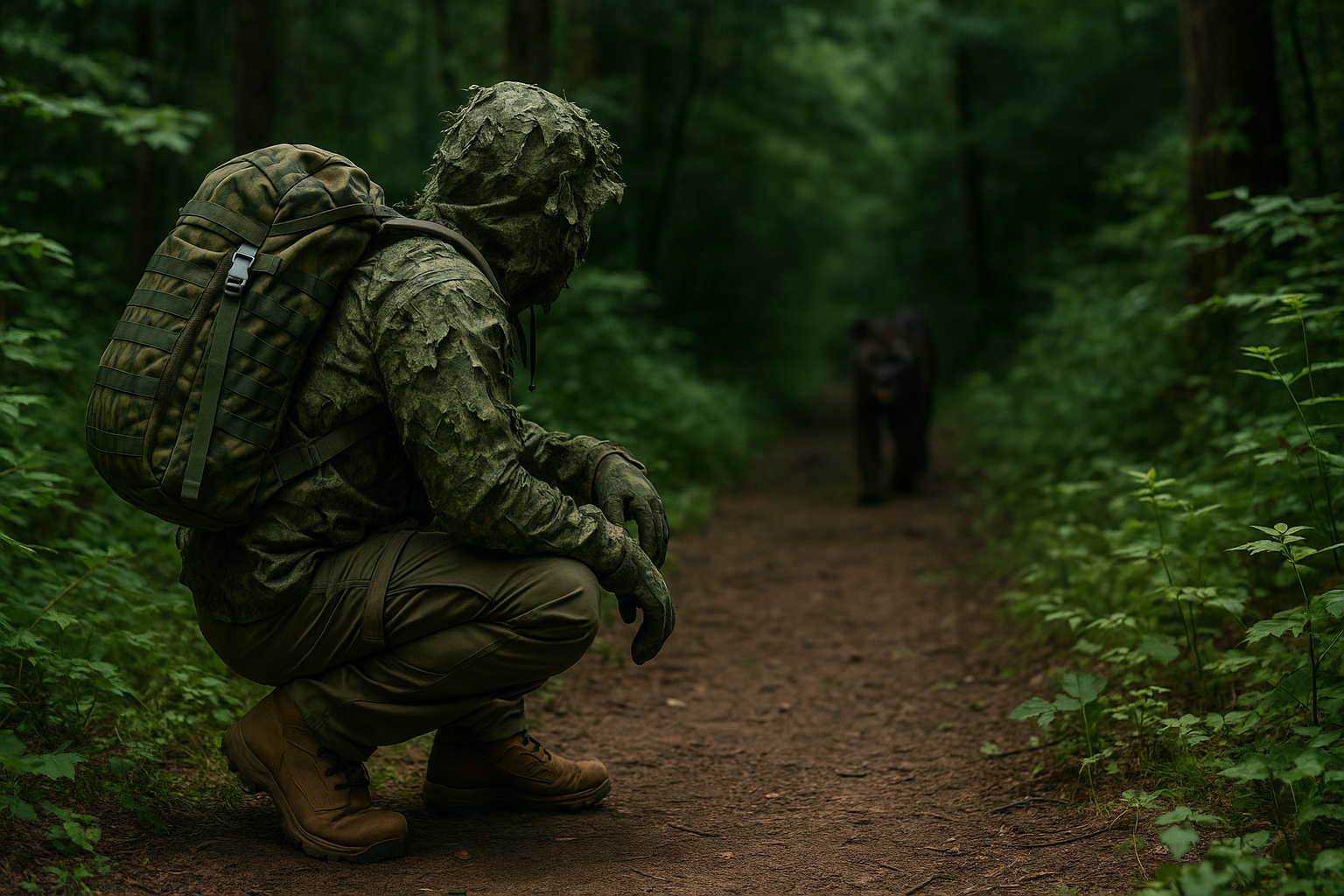You’re Not Alone: When the Wild Turns Silent
You feel it—a presence behind you. The rustle of leaves that stops when you stop. The quiet hush of the wild around you, too quiet. A predator—four-legged or two—is on your trail. There’s no cell service, no backup, and no time for error. It’s not about fighting back; it’s about vanishing before the danger closes in.
In a real-world scenario like this, your survival hinges on stealthy, low-profile gear designed to help you slip away unnoticed, leave no trace, and avoid a direct confrontation.
1️⃣ Ultra-Quiet Movement Gear: Silence Every Step
Every movement you make can either reveal your position or keep you hidden. Regular trekking boots, with their loud crunch of gravel or breaking twigs, are liabilities. Instead, equip:
- Stealth-Profile Minimalist Trail Shoes (like the Xero Shoes TerraFlex II, Amazon): Lightweight, close-to-ground soles reduce sound and increase feel. They let you glide over terrain instead of stomping through it.
- DIY Footwraps: Improvise with layered wool socks or cloth to muffle footfalls. Secure with duct tape or cordage.
- Gaiters in Camo or Earth Tones: Not only protect your legs but also reduce rustling from grass and brush.
💡 Field Tip: Practice silent walking—place your foot down toe-first, then gently roll the rest of the foot down. This “fox walk” reduces noise and vibration that predators can sense.
2️⃣ Disruptive Camouflage Cloaks and Covers
Predators—animal or human—rely on vision to track you. Break up your outline with:
- Ghillie Ponchos or Cloaks (like the North Mountain Gear Ghillie Suit, Amazon): Choose natural green/brown blends that mimic your surroundings. These lightweight ponchos are breathable and can double as makeshift shelters.
- DIY Mud or Charcoal Smearing: If you lack gear, cover exposed skin and shiny surfaces with mud, charcoal, or ash from a firepit to blend in.
- Matte-Finish Backpacks and Gear: Avoid shiny buckles, zippers, and reflective patches. Opt for stealth matte finishes.
🧠 Advanced Move: Use natural vegetation (leaves, ferns, twigs) to add texture to your cloak. Secure with rubber bands or string.
3️⃣ Low-Profile, Non-Reflective Defensive Tools
If detection is inevitable, be ready—but stay silent and controlled.
- Compact Fixed-Blade Knife (like the Gerber Ghoststrike, Amazon): Small enough to conceal, razor-sharp, with a low-sheen black finish.
- Collapsible Baton (available on Amazon): Compact, easily stashed in a side pocket. Choose one with a matte black coating to avoid glare.
- Pepper Spray with Range (like Sabre Tactical, Amazon): Designed for wilderness use. Keep it clipped where it’s instantly accessible.
🎯 Critical Tactic: Avoid waving weapons around. The goal is stealthy readiness, not intimidation. Conceal tools until absolutely necessary.
4️⃣ Scent and Sound Discipline
Predators don’t just see—you’re giving them cues with scent and sound.
- Odor-Neutralizing Clothing Wash (like Dead Down Wind, Amazon): Designed for hunters, these detergents strip human scent from clothes.
- No Cook or Strong-Smelling Food: Stick to odorless rations—plain crackers, sealed energy bars. Avoid canned fish or spicy jerky that can attract animals.
- Minimal Talking or Radio Use: If you must communicate, use hand signals or prearranged silent codes with your group.
🌿 Environmental Hack: Rub crushed pine needles or dry leaves on your skin and gear to mask human scent with local vegetation.
5️⃣ Escape Routes and Camouflaged Retreat Gear
Before a trek, map out multiple retreat routes—ones that double back, disappear into terrain, or descend into ravines. Cache lightweight camouflage gear along your route:
- Emergency Camo Tarps (like the Aqua Quest Defender, Amazon): Compact, multi-use for quick cover.
- Stealth Poncho and Shelter Kits: Ultralight, multipurpose, in natural colors.
- Trail Markers with Natural Materials: Arrange sticks, stones, or stacked logs to mark hidden turns—visible only to you.
🔥 Pro Trekker Tip: If you suspect you’re being tracked, double back along animal trails or dry streambeds, covering tracks with brush as you move.
6️⃣ Ultra-Compact Signal Blockers (Optional for Human Threats)
In rare cases, your predator might not be wildlife. In regions where human threats (poachers, hostile parties) are real, consider:
- RFID Signal Blockers and Faraday Bags (Amazon): Conceal GPS-enabled devices, credit cards, and even phones in these pouches to prevent tracking.
- RFID-Blocking Wallets and Backpacks: Low-profile gear that looks ordinary but shields electronic signatures.
⚠️ Caution: Only use signal blockers if you’re certain you need to evade detection; disabling communication also cuts off emergency help.
7️⃣ Stealth-Focused Lighting Tools
Forget big lanterns or high-beam flashlights. Go stealth:
- Red or Green Lens Headlamp (like the Black Diamond Storm 400, Amazon): These colors reduce visibility to predators and preserve your night vision.
- Micro LEDs or Glow Beads: Dim, pinpoint light sources to mark a path without broadcasting your location.
- Cover Your Light: Even red lights can give you away if carelessly used. Always shield with your hand or angle downward.
8️⃣ Pack Weight and Noise Discipline
Heavier packs make more noise and slow you down. Streamline your load:
- Use ultralight dry bags (Earth Pak, Amazon) to compress gear.
- Pack items tightly to prevent rattling.
- Avoid gear with metal jingles—wrap in cloth or foam where necessary.
🔒 Advanced Tactic: Train to move with your packed gear silently at night. Practice balancing weight for agility.
Conclusion: Silence Is Your Shield
In the wilderness, silence, camouflage, and discipline are your first lines of defense against predators. It’s not about confronting danger head-on—it’s about making yourself invisible, unpredictable, and untraceable. Pack gear that supports stealthy evasion, plan your routes with care, and above all, stay calm and quiet.
A predator—whether a wild animal or a dangerous person—can’t attack what it can’t find.

